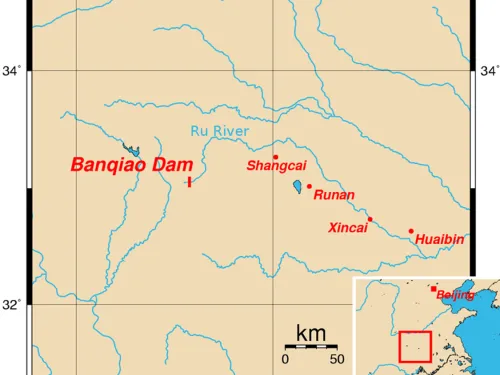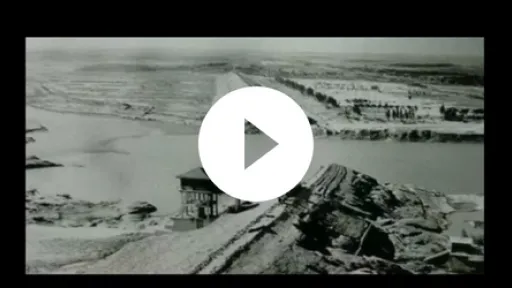Banqiao Dam (China, 1975)
Construction of Banqiao Dam began in April 1951 and was completed 14 months later, in June 1952. Constructed on the Ru River in Henan Province, China, it was part of a larger project to provide flood control, irrigation water, and electrical power to the region. The dam was constructed as a clay core surrounded by a sand shell and had a structural height of approximately 80 feet, with a normal reservoir capacity of 399,000 acre-feet and an additional 304,000 acre-feet reserved for flood storage. Five sluice gates provided a maximum discharge capacity of 62,000 cfs.
Banqiao Dam was constructed with the assistance of Soviet consultants in the years prior to the Chinese Great Leap Forward. The construction of Banqiao Dam and others in the area was prompted by severe flooding in the Huai River Basin in 1949 and 1950. Shortly after Banqiao Dam was completed, cracks were observed in the dam and sluice gates. From 1955 to 1956, Banqiao Dam was repaired, reinforced, and raised by nearly 10 feet in accordance with Soviet construction specifications. Following this rehabilitation, Banqiao Dam was seen as unbreakable and was given the nickname "Iron Dam" to reflect its perceived invincibility. Banqiao Dam functioned as intended for nearly two decades, reducing downstream flooding and providing reliable irrigation water for the rapidly developing region.
The dam was not without its detractors, however. Chen Xing was a hydrologist working for the Chinese government who expressed his disagreement with the government's ambitious plans to build a series of dams both regionally and across China, including Banqiao Dam. Chen had many concerns, including skepticism of the government's primary focus of water storage to the detriment of other water conservation and flood protection measures. He was also concerned that the reservoirs could raise the local water table to such a degree that agricultural fields could become waterlogged or experience increased levels of salinity, rendering the land nonarable. Presciently, Chen was also worried about what might happen if one of these massive dams were to fail.
Following what they interpreted to be First Chairman of the People's Republic of China Mao Zedong's instructions, government officials pursued ever more ambitious goals of retaining more water by constructing ever larger dams and eliminating what was perceived to be unnecessary conservatism in the designs. One such example comes from 1958 when Chen was working on the dam that would create Suya Lake Reservoir. Chen's design for the dam called for twelve outlet gates, but this was deemed "too conservative" by a deputy head of the water conservancy department in Henan Province. This official arbitrarily reduced the number of gates from twelve to five. In retaliation for his outspoken criticisms of this and other issues, Chen was labeled a "right-wing opportunist" and removed from his job.

Had hazard classifications existed in the early 1950s, Banqiao Dam would have met the standard for a high hazard classification based on the likelihood that a failure or misoperation would lead to the probable loss of one or more human lives. Modern dam safety practices would call for a high hazard dam to be designed to pass an extreme such such as the probable maximum flood (PMF). Probable maximum flood is defined as "the flood that may be expected from the most severe combination of critical meteorologic and hydrologic conditions that are reasonably possible in the drainage basin" (40 CFR § 257.53). A PMF is not typically discussed in terms of return period, but it is understood to be an extremely rare event, perhaps on the order of 1 in 10,000 or even more remote out to 1 in 1,000,000. A justification for utilizing such a high bar ("the most severe combination … reasonably possible") is that dams are unique among man-made infrastructure in their ability to cause devastation and life loss in the event of a failure. The lessons that led to our modern dam safety practices are as well-documented as they are tragic.
Banqiao Dam and many others both in China and elsewhere during this era were designed based on a more limited set of data than what we have available today. Even with today's highly detailed precipitation records, sophisticated computer simulations, and complicated statistical analyses, estimating a probable maximum precipitation (PMP) depth relies on extrapolation from a limited set of data. Seventy-plus years ago, dam builders faced the same challenges – what should be the basis of design for a dam? – but they had to solve them without the significant advantages that our modern tools offer us. In the case of Banqiao Dam, the design storm was selected to be a 1,000-year event of 20.9 inches over three days. It is unclear how this design storm was selected, as this documentation is not publicly available. Perhaps the designers and government officials sincerely felt that this was an adequate level of protection for the dam to provide. One hopes that 20.9 inches in three days at least exceeded anything in the records available at the time. Or perhaps the government officials in charge of the design and construction were under the common misconception that a 1,000-year event happens at a predictable interval and only once in 1,000 years. Regardless of the decisions that led to the selection of the design storm, in the summer of 1975, the dam experienced a flood, the magnitude of which the designers likely considered impossible.
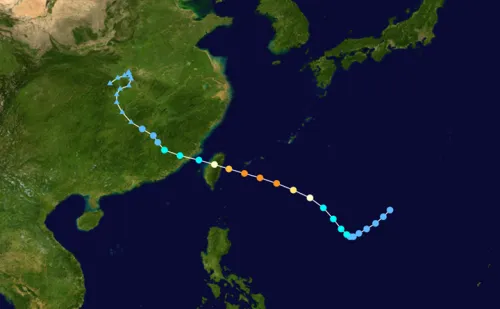
Beginning on August 5, 1975, Typhoon Nina arrived over southern Henan Province and released nearly 18 inches of rainfall over the region – approximately 45 percent of typical annual precipitation and an amount which exceeded the previously highest recorded rainfall by nearly 40 percent. Water levels rose within reservoirs throughout the region, including at Banqiao, which was brought nearly to maximum capacity on the first day of the storm. The sluice gates were opened, but they were not able to discharge at their maximum capacity due to the accumulation of silt against the upstream face of the dam. The Banqiao Reservoir Management Bureau offices were located along the reservoir rim and were also flooded by the rising reservoir levels. This knocked out telephone service and severed contact with weather stations monitoring the storm, making emergency notifications practically impossible. To make matters worse, Typhoon Nina hit a cold front which caused the storm to stall over the Henan region.
The following day the deluge continued, dropping rain for sixteen hours and bringing the water level behind Banqiao to well above safe operating levels. August 7 brought another thirteen hours of downpour, and the water behind Banqiao continued to rise. Without the ability to communicate, the operators at Banqiao were unable to receive instructions or inform the government of the current conditions at the dam. In addition, Banqiao's reputation as the invincible "iron dam" led to it being overlooked when government officials were assessing the dangers posed by the ongoing flooding. In the waning hours of August 7, as the water level continued to rise and the embankment began to be overtopped, workers formed a human chain, attempting in vain to repair the embankment even as it began to erode.

Banqiao Dam experienced overtopping depths of approximately one foot before the dam embankment began to disintegrate. Beginning at approximately 1:00 AM on August 8, a flood wave of nearly 500,000 acre-feet moving at over 30 miles per hour (44 feet per second), with depths in excess of 30 feet, ripped through the farms and villages downstream. As the dam gave way, one worker reportedly cried out "The river dragon has come!" in reference to an old folktale. It took approximately 6 hours for the reservoir to drain. The failed dam discharged an estimated peak flow rate of 2.8 million cubic feet per second which generated a flood that was over 7 miles wide and covered 3 million acres (approximately the size of the state of Connecticut). Due in part to the failed communication lines, a warning was not sent out in time to allow for an adequate evacuation. Villages in the immediate vicinity were nearly completely washed away, and since no warning was given, many of the residents perished. Due to many factors, it is impossible to determine an overall fatality rate; however, local estimates are terrifyingly high. In Qianhu Village, for example, the fatality rate is estimated at 63.5 percent (RCEM, Reclamation 2015).
Banqiao Dam and 61 other dams in the region failed in the early morning hours of August 8, 1975. Due to the Chinese government's control over journalism and the media in the 1970s (and continuing even today), the true extent of the damages was never accurately captured. Total fatality estimates vary widely, and even China's official estimate has changed over time. Officially, China states that 26,000 people died due to the many dam failures in the region. However, this figure fails to consider the indirect fatalities caused by disease outbreaks and famine that decimated the area in the weeks and months following the actual failures. In a 1995 report, Human Rights Watch cited a total death toll of 230,000 – the vast majority of which are attributed to starvation, disease, lack of clean drinking water, extreme mid-summer heat, infection of untreated wounds, etc. These deaths were not for lack of trying on the part of the Chinese government.
The Chinese government did try to assist those impacted by the floods: food and supplies were air-dropped to attempt to assist the millions left stranded (more than 1 million were believed to still be trapped by flooded conditions more than a week after the dam failures), but 50 to 60 percent of the food landed in murky and contaminated waters, rendering it unsafe to eat even if it was able to be retrieved. The Chinese government prevented news of the failures from being reported on or broadcast nationally. As a result of this censorship, very little about the failures was known outside of the areas that were directly impacted. China's Ministry of Water Resources and Electric Power released a study in 1989 which stated that 85,000 people died instantly due to the flood wave. This figure was later withdrawn and replaced with the current official accounting of 26,000 dead, all lost during the flood wave. Eight members of the Chinese People's Political Consultative Conference (the highest government advisory body) produced the estimate of 230,000 deaths, which was not widely disseminated until the 1995 Human Rights Watch report. These eight people were all high-ranking government officials and were among China's foremost experts in water conservancy and technology. Given their high ranks, it is likely that these individuals had access to confidential government reports on the 1975 disaster. These individuals also estimated that more than one-third of China's dams should be considered unsafe.
Government reports on the 1975 dam failures were kept confidential until 2005. In the years following the failures, many failed dams were rebuilt, including Banqiao in 1993. It is unknown whether there was any public opposition to the reconstruction of these dams; however, it seems unlikely that any such opposition could have stopped the Chinese government's plans for developing dams. According to the World Commission on Dams, as of 2000, China had over 22,000 large dams, nearly half of the world's total number, which is surely greater today.
According to the World Register of Dams, Banqiao has a spillway capacity of approximately 530,000 cfs and a reservoir capacity of 547,000 acre-feet. The spillway now has eight large radial gates with a large stilling basin.
Lu Youmei, the former head of China Three Gorges Corporation, oversaw the development of the Three Gorges Dam from 1993 to 2003. Youmei is quoted as saying, "Every dam is considered and designed carefully based on hydrology and the most severe flood in history." With the realities of climate change, basing the design of a dam on past documented events no longer yields the conservatism it may once have. The failure of Banqiao Dam highlights the devastating consequences of not considering extreme events in the design of a high hazard dam.
Lessons to be Learned
The concept of a "probable maximum precipitation," which considers not only documented extreme events but also extrapolates that data to theoretical maximums of precipitable water, among other factors, can be difficult to understand, as can the probabilities relating to the occurrence of such extremely rare events. Adding to this difficulty is when the annual exceedance probability computed for a probable maximum precipitation event is expressed in the form of a return frequency (e.g., "100-year storm"), and the resulting value is in the tens or hundreds of thousands of years. This can provide a false sense of security where the event seems so exceedingly rare that it will effectively never occur. But extreme floods do happen, and climate change is making what used to be infrequent storm events more common. The selection of a design storm must take these events into account, particularly for high hazard dams where lives may be lost due to underestimating potential magnitude of extreme flood events.
Dam Incidents and Failures can Fundamentally be Attributed to Human Factors
While the failure of Banqiao Dam was caused by a large storm that behaved unpredictably and dropped an incredible amount of rainfall, the failure was an entirely man-made disaster which was decades in the making. The selection of design storm (approximately a 1 in 1,000 event) did not include adequate levels of conservatism, which directly led to an undersized spillway with inadequate flood storage and freeboard considerations. The political climate of the time also may have influenced the selection of a smaller design storm to reduce the cost of design and construction that a larger storm would have required. The offices (and presumably control room for the dam) were located in a building that was within the inundation zone of the reservoir. This led to the building being uninhabitable and contributed to the failure of the communication lines. The failure of the communication lines and the lack of redundant means of communication made it difficult, if not impossible, to disseminate an adequate warning to the areas downstream. Inadequate communication of the unfolding disaster coupled with the flawed perception of the dam as invulnerable (the "Iron Dam") led Chinese officials not to consider that Banqiao could potentially pose a risk of failure during the intense rainfall. The suppression of reporting and information gathering about the failure may have impacted rescue and recovery efforts and resulted in a lack of clarity regarding the true magnitude of the tragedy.
Dozens of Dams can Fail or be in Danger of Failing During a Single Event (i.e., Swarming Failures)
Dam owners and regulators need to prepare for these types of events. The failure of a single dam causing another dam downstream to fail (cascading failures) is often considered when performing dam break analyses. Perhaps less frequently considered are region-wide events such as tropical storms, hurricanes, or rapid snowmelt which can impact dozens or hundreds of dams at the same time, causing multiple simultaneous failures, like what happened to the 62 dams that failed in August 1975.
Many countries, including China and the US, have large inventories of aging dams. These dams may have also experienced hazard creep over the decades since being constructed, which creates additional risk that the designers may not have accounted for. Evaluating these dams in light of their current hazard classification and using modern hydrologic tools will become increasingly important so that deficient dams can be identified.
References
This case study summary was peer-reviewed by Seth Thompson, P.E., Gannett Fleming.
Lessons Learned
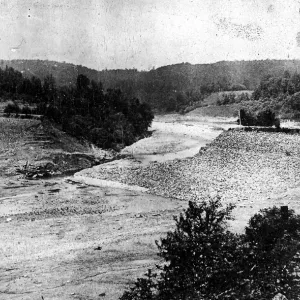
Dam incidents and failures can fundamentally be attributed to human factors.
Learn more
Dozens of dams can fail or be in danger of failing during a single event (i.e. swarming failures). Dam owners and regulators need to prepare for these types of events.
Learn more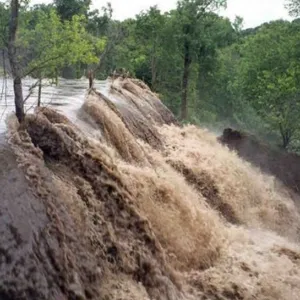
Extreme floods do occur.
Learn more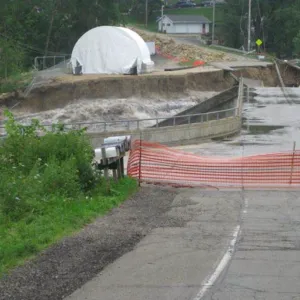
High and significant hazard dams should be designed to pass an appropriate design flood. Dams constructed prior to the availability of extreme rainfall data should be assessed to make sure they have adequate spillway capacity.
Learn more
Federal Guidelines for Dam Safety - Emergency Action Planning for Dams

Federal Guidelines for Dam Safety - Hazard Potential Classification System for Dams
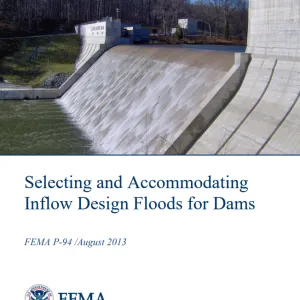
Federal Guidelines for Selecting and Accommodating Inflow Design Floods for Dams

Summary of Existing Guidelines for Hydrologic Safety of Dams

